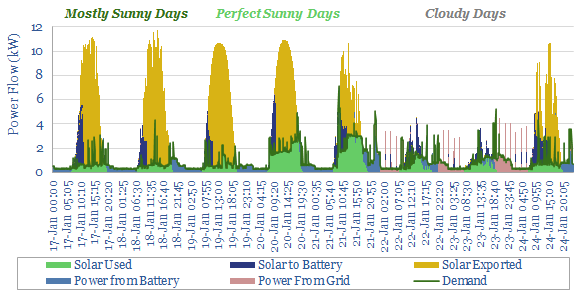This data-file is based on actual power flows, kindly shared by a client of Thunder Said Energy, who is based in sunny Australia, with 13.5kW of residential solar panels and the 13.5kWh Tesla Powerwall system as a back-up. The solar plus battery data imply that a
This file of solar plus battery data includes 5-minute by 5-minute power flows, over the space of a week in summer, from which we have imputed solar generation, direct consumption, battery inputs, grid exports, later battery drawdown, final power consumption and grid draws.
Daily average data are also drawn over the space of a year, to get a longer-term perspective, including variability by season.
Self-sufficiency. This property has an average annual power demand of 0.84kW (1.2kW in the day, 0.4kW at night).
This solar plus battery system is supplying an impressive 92% of the house’s year-round power needs.
But is the solar over-built? Two-thirds of all the solar generated over the year had to be be exported to the grid. It raises the question of how much solar a grid can absorb. Below, we consider three solutions to address this challenge…
(1) Should the home-owner build more batteries to avoid having to export so much power to the grid on sunny days? It is unclear that this would help to absorb more of the excess solar energy. Because in the first four nights shown in our chart above, this system did not manage to discharge its existing battery entirely before the sun started blaring again. So if you were to build more batteries, purely for the house, their utilization would be very low.
(2) Build more batteries for cloudy days? During the 2.5 cloudy days above, the battery quickly became depleted, and this is why the house became reliant on the grid. Looking over the full year, cloudy days are 60% auto-correlated. Hence to get through winter purely on a battery would have required 17 x fully charged Powerwalls (c$200k cost).
(3) Buy an EV or mine some bitcoin? Our biggest conclusion is that renewable-heavy grids need to absorb excess renewables. This creates an exceptional opportunity for demand-shifting, for example in EV chargers, especially when you consider the round-trip efficiency on the Powerwall is 87%. There is also an upgrade cycle ahead in power-electronics (note here). And finally, using excess renewables avoid denting the utilization rates of other grid infrastructure, which is one of the paradoxical reasons that renewables can be inflationary.
Please see the links for out top conclusions into solar in the energy transition, power grids and energy storage.
Any sales proceeds from this download will be donated to nature-based CO2 removals projects, reflecting the generosity of the client that supplied us with this data-set.
